This is the source text of a speech I gave at Gnomedex in 2007. Here’s a video of me giving this talk.

A few years ago my grandmother passed away, and I found this telegram among her possessions. It’s from her uncle to her father. If you can’t read it, it says “Dad died yesterday. Burial Tuesday, two o’clock, Aurora.” How about that economy of language? You paid by the word, so condolences could wait until next Tuesday.
This was sent in 1954, and at the time it cost about $2.50 Canadian. That’s about $2.57 in US dollars. Yes, our currency was stronger until about 1960. I don’t know if the Americans in the audience have looked at exchange rates lately, but we’re coming for you.
In 2007 dollars, $2.50 is worth $19.84 Canadian. Imagine if you had to pay nearly two dollars for every word you wrote in an email. What would spam look like?
Send $ to Nigeria. Thx.
If we think of it in some different ways, $19.84 in Canadian dollars is also:
- $18.64 US dollars
- ¥2,214 Japanese Yen
- £5.84 in Maltese Lira (I’m living in Malta right now, so I like to convert to the local currency)
Do you hear that sound? That’s half the room hitting up Google Maps to find out where Malta is. It’s here, incidentally:
It also works out to:
- L$4,986.62 Linden dollars
- 249 World of Warcraft Gold
The second number is the black market conversion, so rates may not be very stable.
My great-great grandfather dies. My great-grandfather sends a telegram to my great-great uncle. My grandmother keeps the telegram. She dies, and the telegram comes into my possession. It’s enough to make you think about your own mortality.
Two
So that’s what I’ve been doing lately. Thinking about life and death and how I want to be remembered. Here’s one way I might be remembered if I keeled over right now on this stage:
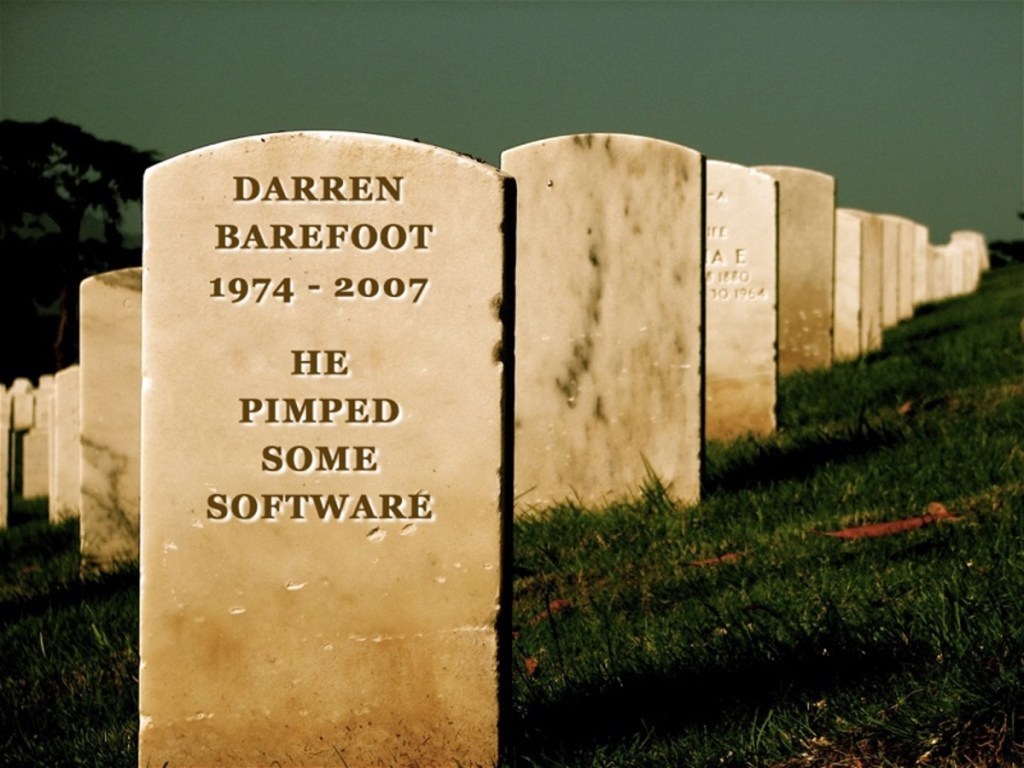
My day job, you see, is doing marketing for high-tech companies. That’s not really a satisfactory legacy, is it? I’ve been thinking about ways to improve on that. Ways to revise what gets written on my gravestone.
Ways to do good.
Or more good, at least, because I have done projects here and there to raise money for good causes. And my wife and I do occasionally make donations to non-profits and charities. I just haven’t been very systematic about it.
Three
When I lived in Vancouver, I’d visit this hot dog stand at the corner of Granville and Georgia. If you find yourself in Vancouver, I highly recommend it. The turkey smokie is out of this world. Be sure to get the fried onions.
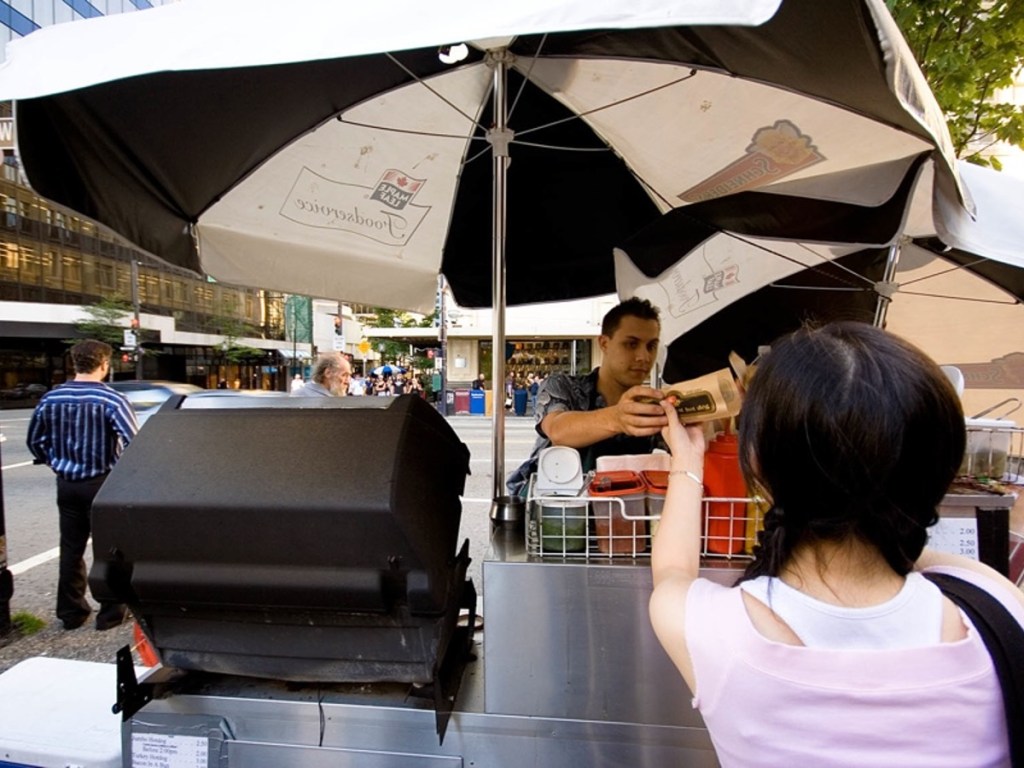
When I frequented this stand, there was often a young woman who sat beside it, leaning against a lamp post. She was homeless. If she wanted one, I’d buy a hot dog for her. I could afford the extra $2.50. The first time I did this, I learned that her name was Stacy.
That little gesture, buying somebody lunch, that seemed like a minimum amount of charity you could do. One act, one meal, a few bucks.
Four
So if I want to do good, and I want to be systematic about it, I need to measure some good deeds. This will help me figure out how to spend my time.
By the way, if you’re an economist or sociologist, you should just leave the room right now. Pretty much everything I have to say from this point is totally half-assed, and if you keep listening, you’ll just end up looking like this:

We need a basic currency for measuring good deeds, so I’m going to go with the aforementioned lunch. One meal for one person. And, in honor of that woman by the hot dog stand, I’m calling it the Stacy. Buy one lunch for one person, and that’s a Stacy. Keep somebody alive for a year, and you’ve earned about 1100 Stacies. The actual dollar amount would vary depending where that person is in the world, but one lunch for one person equals one Stacy.
Five
There are at least six billion ways to do good. But since my work and passion is technology, I’ll focus on some interesting tech and web projects. These are things that, if I were smarter and luckier and started earlier, I might’ve been able to do in a year. With a lot of help.
There is, of course, the question of inventing big things–the infrastructure of the Web. If I built the next Flickr or Linux or Google or whatever, that’d be great. That technology is used to do immeasurable good. And bad. But I’m sure the good outweighs the bad (with the exception, perhaps, of MySpace). But I’m not that smart or lucky.
And besides, there’s a kind of reductio ad nauseum there. After all, if I got in the game early enough, I could have built the wheel.
And just so you know, I’m not some kind of hippie. I’ve never been to Burning Man. I’ve never touched a bongo drum. I do have one pair of sandals, but they’re very sporty.
In thinking about these, hopefully they’ll give me a better sense of where I should spend some time. And maybe they’ll inspire somebody in this room to build something just as cool.
Six
Nabuur
What if I want to volunteer my time to help a developing nation, but I’m too lazy or scared or busy to leave my living room? This is Nabuur. It enables you to offer your volunteer expertise from your own home. Nabuur provides a platform for connecting with over 200 projects and over 8000 volunteers around the world, who contribute a little time and expertise to a project. It’s crowd-sourcing for the developing world.
You could help coordinate the shipping of computers to a school in Honduras, or edit the marketing plan of a village beekeeping project in Sierra Leone.
So what if I contributed a business plan to this project , a program to launch a Masaai ecotourism business in Kenya? They hope to make a sustainable business for 30 families, or about 130 Kenyans. There are currently 22 other volunteers on the project. Obviously the Kenyas are doing the majority of the work–let’s say the volunteers contributed 20% of the effort for the business’s first year.
Once you do the math, my business plan would work out to about 1250 Stacies for the year, or a little more than what it might cost to feed one person for a year.
Let’s put that on a chart.

If you wanted to start closer to home, another project is ICouldBe.org, where professionals mentor teenagers and help them transition to college and the working world.
Geekcorps
This is Geekcorps. Founded in 2000 by Ethan Zuckerman, they’re an organization that sends people with IT skills to the developing world, to help build computer infrastructure, both in terms of hardware and education. They send so-called ‘high capacity volunteers’–these people are professionals, not envelope stuffers–to help set up networks and enable entrepeneurism through technology.
One of their most admirable projects is Moulin Wiki, an effort to deliver an offline version of Wikipedia on CDs to parts of the world who don’t have Internet access. Thus far they’ve launched the French version, and distributed more than 600 CDs across Mali and western African.
So what if I joined Geekcorps and went to Africa for a year? Well, first I’d have to acquire some l33t IT skills, but let’s assume I did that. This one’s hard to measure, because the work I’d do is of the ‘teach a man to fish’ variety. And what if I just helped to build a Wikipedia in one of the local languages–another Geekcorps project? How much is that worth?
Say I was able to set up some infrastructure that enabled five people to get jobs. They’re doing the work, they’re able to feed their families, so I could take only a fraction of the responsibility for that success. I’m going with 9,500 Stacies.
Just Earn More Money
Before we move past simple volunteering into projects I wish I’d invented, I wanted to consider one alternative that many economists advocate. They say that if you’re employed, you’re much better off working more and donating the extra earnings to charity.
It’s simple math. If I work in a soup kitchen for two hours, I might make enough soup to feed 50 people. Imagine if I just worked an extra two hours, and earned, say, $200, and donated that money to the same soup kitchen. They could hire 5 skilled cooks, and feed hundreds of people and make better soup than I could.
Of course, people are chintzy, and they like the good feelings they get from volunteering. In one study I saw evaluating volunteerism and giving, most countries had a much higher percentage of volunteers than donors. The US and Canada are exceptions to this rule. We’re great givers, but lousy volunteers.
So let’s imagine that I work an extra four hours a week. That’s 16 hours a month. Say I earn $1600 for that time. The average cost of a meal in a soup kitchen in the US seems to be about $1.20. So that works out to 1300 Stacies a month, or about 16,000 Stacies for the year.
Of course, if I went over to Uganda or Sierra Leone, I could buy four meals for the price of one meal in a North American soup kitchen, so that would earn me more than 66,000 Stacies.
Build Something in a Virtual World
It’s hard to make stuff. Particularly when we’re talking about buildings and machines. It’s far easier to make virtual versions of stuff. Can you do good in virtual worlds?
Second Chance Trees is a project in partnership with Plant It 2020, a non-profit founded by John Denver in 1992. Their passion is the planting, maintaining and protecting of indigenous species around the world. They set up an island in Second Life where players could buy and subsequently plant virtual versions of endangered rain forest trees.
Each tree cost 300 Linden dollars, which is currently about $1.12 US. When users bought a virtual tree, a real-world tree was planted. Thus far, they’ve sold 500 trees in Second Life, which gets them 500 real-life trees.
We obviously have a problem here, because my Stacy currency is a measure of helping people, not the environment. But, because it’s my currency, I’m going to say that one tree planted or saved equals one Stacy. Thus, Second Chance Trees is currently worth 500 Stacies.
This is a yak.
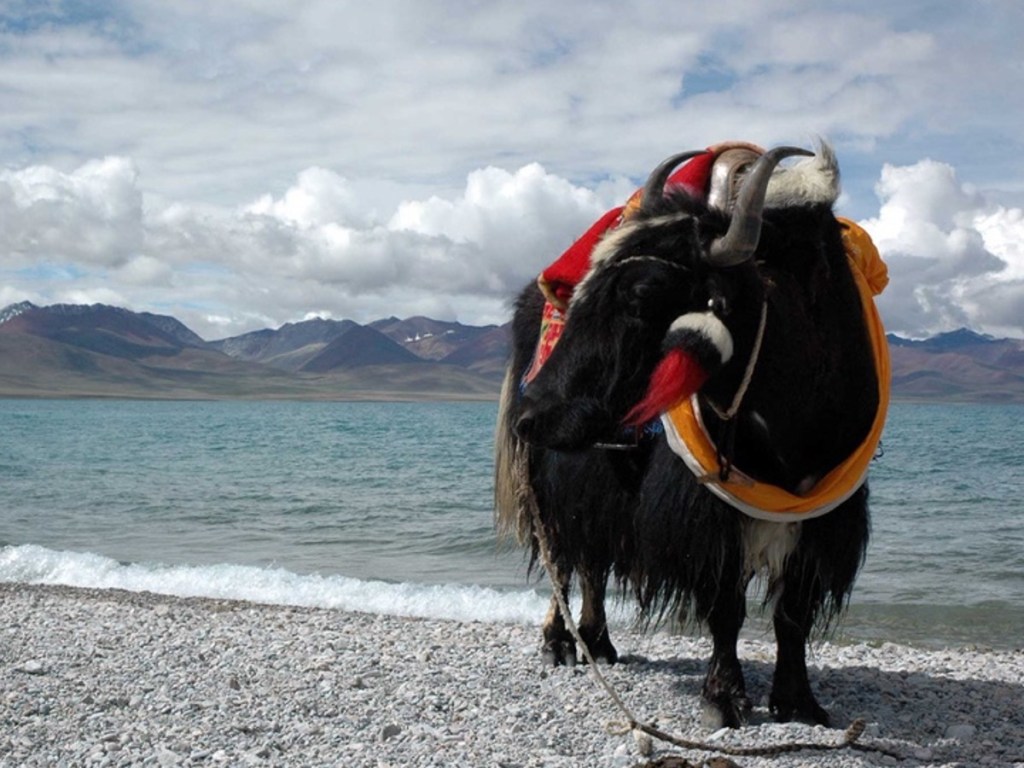
This is a virtual yak.
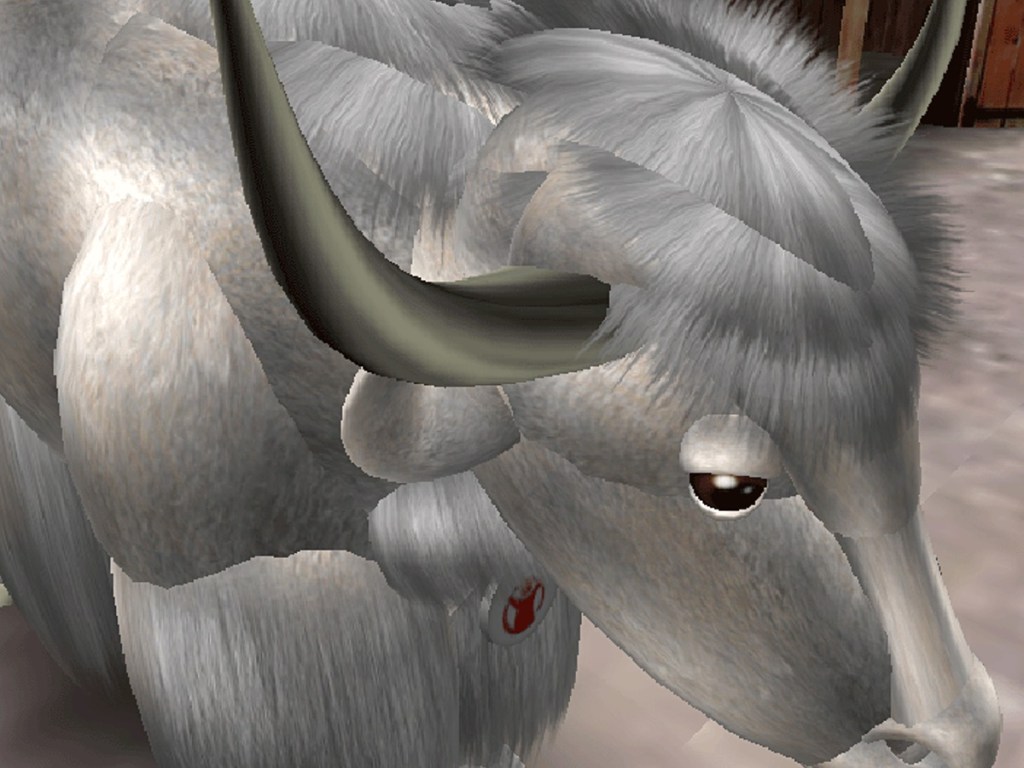
Save the Children is a British charity which focuses on providing health care, food, education and safety to the world’s poorest children. They devised a clever idea along similar, virtual lines. They launched a yak ranch in Second Life, and invited players to buy a virtual yak. The virtual yaks produced virtual milk, and you could ride the virtual yak with your virtual self. I saw a demo of the yak in action, and the animation on the walking must have been tricky, because it’s actually more of a hover yak.
The money they paid, 1000 Linden dollars or about US $3.75, goes to buy actual yaks for actual families who need them. For an impoverished family in Nepal or Mongolia, a yak can make the difference between abject poverty and a sustainable existence.
They sold over 200 yaks, raising 225,000 Linden dollars. That works out to about $800 in US dollars. I wasn’t able to figure out how many actual yaks that would buy, but let’s assume the money goes to food aid in the developing world. That would earn about 2700 Stacies.
They didn’t raise much money, but they did get a lot of real world press. That works because they’re early adopters–it’s not every future virtual fundraising campaign that will generate that kind of media attention.
Happiness
Let’s change gears for a minute. What about happiness?
As you may know, the king of Bhutan coined the term Gross National Happiness in 1972, and made it a priority for his tiny Buddhist nation.
This is him right here, with his son, the current king:

People take this idea very seriously, as it turns out. There’s a body of economic theory dedicated to studying GNH as a new paradigm and a viable alternative to Gross Domestic Product. There was a conference two years ago in scenic Antigonish in Nova Scotia, and this year there’s one in Bangkok.
There’s no question that being happy feels good, but how much good are we doing by making people happy? And how do we quantify happiness?
Well, we’re not sure yet, but people are working on it.
Adrian White, a psychologist at the University of Leicester, created something called The Satisfaction with Life index. It’s based on a bunch of sources, but essentially associates happiness with health, wealth and access to basic education, in that order. In her world, Denmark is the happiest country, and Burundi is the least happy. Green and then blue are most happy, orange and then red are least happy:

We also know that happiness has an impact on health. Research has demonstrated that laughter increase blood flow, strengthens the heart, decreases stress, bolsters the immune system and so forth. A good sense of humour helps you live longer. There was a study of 54,000 Norwegians over seven years which categorized participants according to their humor appreciation. If you ranked in the top quarter, you were 35% likelier to be alive at the end of the seven years than if you were a Debbie Downer in the bottom quarter.
Could I help people simply by amusing them? Here’s where I’ve got some data.
I made this goofy little satire site called GetAFirstLife.com. About 600,000 people have visited the site, and they seemed to like it. How much did they like it? I asked around, and it seemed like the site was worth about 15 seconds of laughter, on average, per person. That works out to 2500 hours of laughter.
As a second data point, I wrote this play, called Bolloxed. It played at some Fringe Festivals, and 600 people saw it. It was a comedy, and, again, people seemed to like it. It got good reviews, and people laughed a lot. Why not? It featured a pair of talking testicles:

I’d say people laughed for 15 minutes. That’s only 90 hours of laughter. To match my satirical website, I’d have to either be much funnier, or get another 10,000 people to my plays.
But what does the laughter generated by GetaFirstLife.com do to our chart? It’s impossible to know. I’m going to go out on a limb, and give myself 500 Stacies:
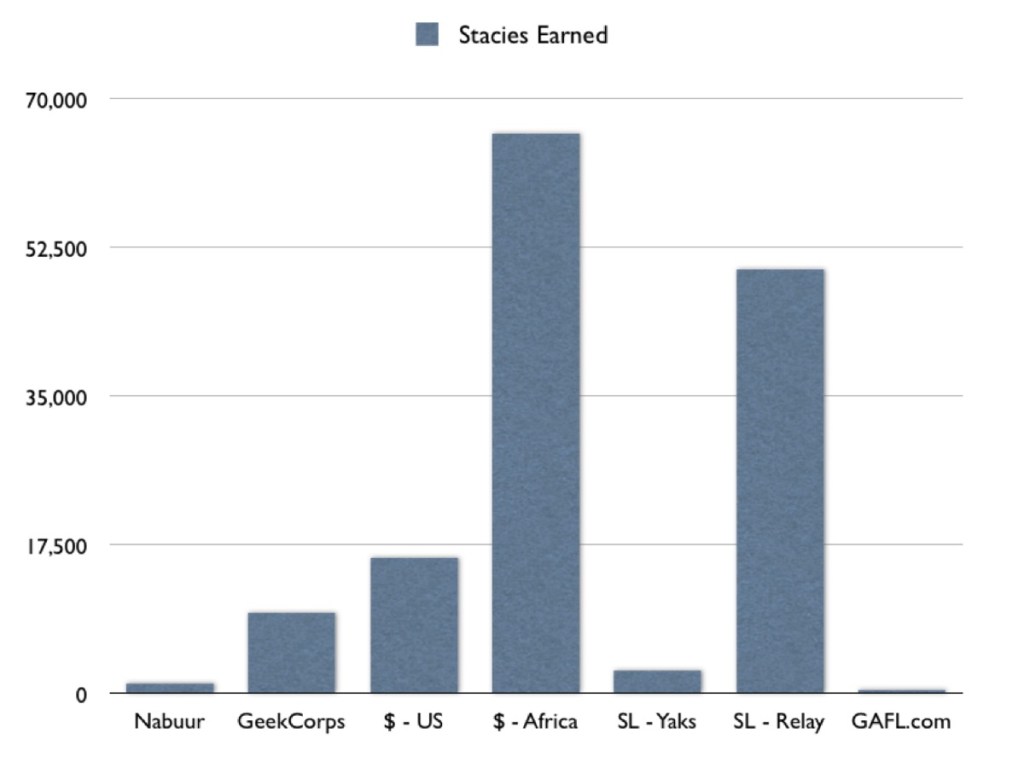
Nothing But Nets
This is a mosquito net. In sub-Saharan Africa, malaria is a top-five cause of death. It kills one child under five every thirty seconds.
In 2006, Rick Reilly, an award-winning writer for Sports Illustrated, wrote a column called “Nothing But Nets”. He’d recently learned about the way malaria ravages Africa, and for the first time in 21 years, asked his readers to do something. He implored them send 10 bucks to the UN Foundation, so that they could buy a net like this for an African family.
He launched a meme. That initial column raised $1.4 million. As soon as they could, the UN Foundation launched NothingButNets.net, partnering with folks like Sports Illustrated and the NBA. The real partners, though, were the thousands and thousands of people who used the site to launch their micro-campaigns among their friends and family.
This site is typical of the sort of big charity run and walk sites–it’s kind of a Pyramid Scheme of Good. The site is a tool that enables others to do good.
Thus far, they’ve raised over $8 million from donors, enough to buy over 825,000 nets. Each net protects a family for four years, reducing transmission of malaria by up to 90%. By my estimate, those nets have easily saved 50,000 lives, and probably more. How many Stacies for a human life? I’m going with 50,000 each, so that works out to 2.5 billion Stacies:
GiveMeaning
This is Tom Williams, in front of our nation’s seat of government:
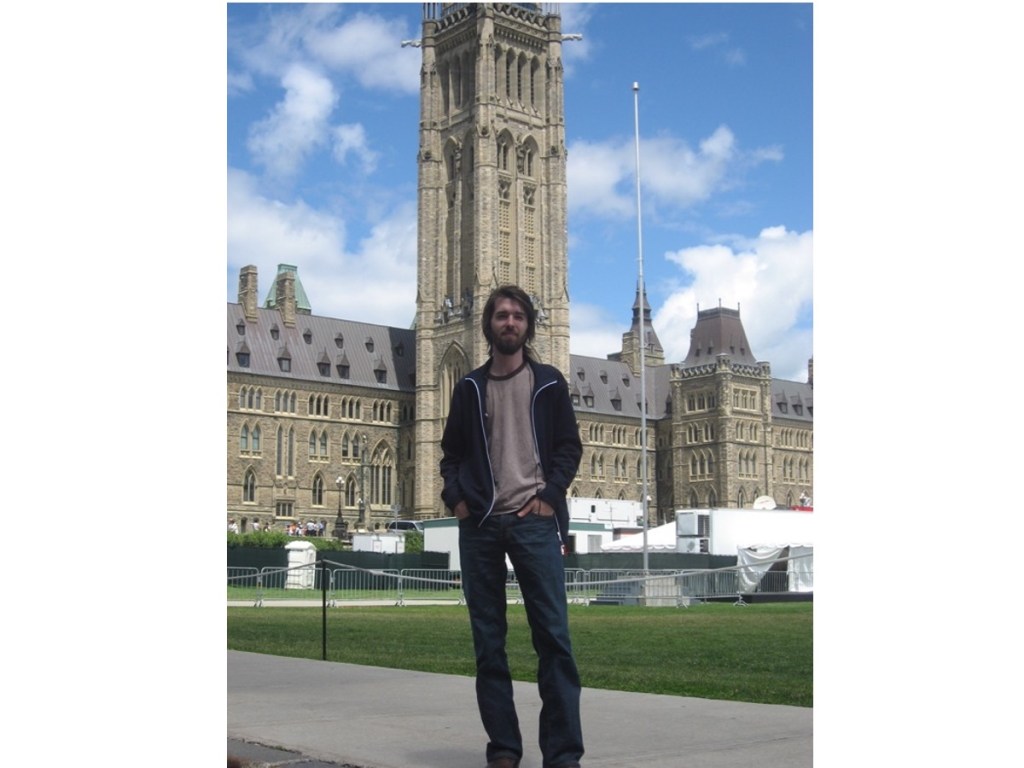
Tom started his career in technology rather auspiciously. At 15, he was Apple’s youngest employee. He went on to be a VC fund manager. That life motivated him to change gears and start GiveMeaning.
Launched in December, 2004, GiveMeaning is another of these Pyramid Schemes of Good. It’s a project-based fundraising site with lots of Web 2.0 bells and whistles. The projects can be about anything, though most of them are concerned with international development and ‘thons’–walkathons, marathons, bike-athons. My friend Michelle used the site to raise a thousand dollars to dig a well for a village in Liberia.
One interesting social aspect of the site is that before you can get your project approved for fundraising, you need to get a hundred ‘votes’ for the project. It’s like trying to get your project Dugg. That consensus of approval is a filter mechanism, and makes it much easier for project leaders to raise money.
So what if I built GiveMeaning? Again, it’s off the charts. They have 1200 active projects, and hundreds completed. A typical project’s goal is to raise about $5000, usually from 20 to 40 donors.
The charts kind of broken by now, but you get the idea.
Conclusion
So what have we learned? The best way to help people is to build an infrastructure that enables a kind of Pyramid Scheme of Good. If, like me, you’re not smart or lucky enough to be able to do that, then all things considered, just earn more money, or spend less, and donate the difference.
Now’s the time when I unveil my project. My kick-ass killer app. The awesome user-generated content, ad-supported, Facebook-enabled, mobile-aware, Ajax-powered thingy. The thing that’ll cure AIDS or give sight back to the blind or whatever, all stored remotely on Amazon S3.
And here it is!
Blank screen.
I’ve got nothing. All I have is this thought experiment and your attention.
When Chris invited me to speak, I asked him what he wanted me to talk about. He asked, “what have you always wanted to bring to Gnomedex?”
I thought about it, and, you know, I could have done a talk about marketing or social media or whatever. But then I thought about these other things, about the telegram and the tombstone and about Stacy.
And I thought that the people in this room are influential and smart and powerful. While I know a bunch of people in the room have done and keep doing amazing things that help millions of people. And trees. and rocks, whatever. But they need to keep doing them.
And those who aren’t, like me, we maybe need to think about starting to do them. I’d like to invent Nabuur or GiveMeaning or this or this or this, but I probably won’t. One of you might, though.
Because if you go invent something brilliant, that helps millions of people. Or you. Or you. Well, not you. Sorry.
If you do that, and I pushed you 1% toward that tipping point, where you invented that thing. Well, 1% of millions of people is a lot of Stacies.
In the meantime, I’m going to try to volunteer more. Give more money to charities I believe in. Maybe give this talk to some other smart people if they’ll let me.
Remember the gravestone? Well, when I finally shuffle off this mortal coil at the age of 96, I hope that future generations will echo some advice that I heard from a Canadian philanthropist named Joel Soloman. He said “Be the best ancestor you can be.”
So, if I work at it, maybe this will become my epitaph:

Thanks for listening.
Photo credits:
Andrew Ferguson from GoldenGod.net, Carina C. Zona, Hughes Leglise-Bataille, Fungus Guy, Kris Krug, Steve Bridger, Nancy Scola, Virtual Bailey, allison, Werner Jankowsky, The Center for International Education at WIS, cie-wis.org, François Proulx, Tomas Krag, Robin Taylor, Tom Williams, Ryan Jesena, Keith, Michael Lehet, Scott Foy, Gregor, Wikipedia, Q-Drum
UPDATE: I talked to a couple of people about fundraising in Second Life, including John Anthony Hartman and Beth Goza. They both explained that the poster child for non-profits in Second Life is the Relay for Life, which raised $41,000! That’s obviously orders of magnitude greater than the projects I profiled, and I should have mentioned it. I admittedly didn’t do much research on Second Life projects, as I already knew about these two interesting ones.
I asked why this project had been so remarkably successful. I guess it’s been running for three years, and has extremely high visibility. Beth also postulated that the cause really resonates with Second Life users (educated, in their twenties and thirties, reasonably even gender split, and so forth).
Very nice, DB. I’m happy I know you.
*claps*
brilliant ideas and execution db. awesome. 🙂
Awesome Post Darren.
Looking forward to seeing the video. We should all try to be better ancestors. It looks a lot better on the gravestone than
“he had a bigger SUV/House/TV than his neighbour”
I loved this post. It made me feel like doing something good for somebody today.
(And I will, as soon as I finish this game of Scrabble on Facebook.)
Stacy was at the post when I walked past yesterday.
I think I’ll buy her a hotdog next time I see her…
Maybe the odd person should buy Stacy a salad; that many hotdogs can’t be good for you.
Nice work, Darren!
I like the Stacy currency and the ancestry reference. Blog fodder and useful classroom discussion topics. Thanks and Great job Darren.
Great job on the presentation. We are processing video of the interview we did with you and will let you know when it is up.
Thanks again for adding to the conversation about how to do good with all these tools and technology.
Great presentation and we should have your interview up shortly. The grand total according to the Second Life Relay for Life site as of today is:
Campaign Total
* L$32,110,590!
WOW!
Great stuff! Cheers!
Excellent 1100 stacies presentation at Third Tuesday Toronto tonight. You provided inspiring, yet tangible ideas. I hope that others who saw your presentation will be motivated to turn their ideas into actions. Hopefully we’ll all become stacy millionaires.